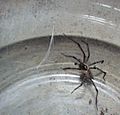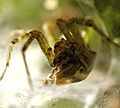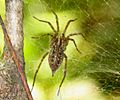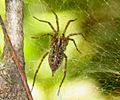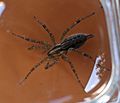American grass spiders facts for kids
Quick facts for kids American grass spiders |
|
|---|---|
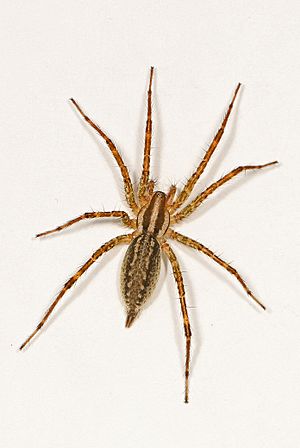 |
|
| Agelenopsis cf. pennsylvanica in Vernon, British Columbia | |
 |
|
| Agelenopsis pennsylvanica in web, from Pocahontas State Park, Chesterfield, Virginia | |
| Scientific classification |
|
| Kingdom: | Animalia |
| Phylum: | Arthropoda |
| Subphylum: | Chelicerata |
| Class: | Arachnida |
| Order: | Araneae |
| Infraorder: | Araneomorphae |
| Family: | Agelenidae |
| Genus: | Agelenopsis Giebel, 1869 |
| Type species | |
| A. potteri (Blackwall, 1846) |
|
| Species | |
|
14, see text |
|
Agelenopsis, often called American grass spiders, are a type of spider known for building special webs that look like sheets with a funnel on one side. These spiders were first described by C.G. Giebel in 1869. Even though their webs aren't sticky, these spiders are super fast runners, which helps them catch their food!
Some of the bigger American grass spiders can grow to be about 19 millimeters long (that's almost an inch!). You can often tell them apart by looking at their eight eyes. They have two eyes on top, four in the middle, and two more on the bottom row. They also have two noticeable parts at their back called spinnerets, faint stripes on their legs, and two dark lines running along their body, from their head to their chest area. These spiders are harmless to humans.
What's in a Name?
The name Agelenopsis comes from two parts. Agelena is a group of similar spiders found in Europe and Asia. The second part, -opsis, is a Greek word meaning "to look like." So, Agelenopsis basically means "looks like an Agelena spider."
While they look alike, there's a cool way to tell Agelenopsis spiders apart from their European cousins, Agelena. Agelenopsis spiders have two almost straight lines that go from their eyes to the start of their abdomen. Agelena spiders, on the other hand, have curved, wiggly lines that often meet at the end.
Types of Grass Spiders
As of April 2019, there are fourteen known types, or species, of American grass spiders:
- Agelenopsis actuosa (Gertsch & Ivie, 1936) – Found in the USA and Canada
- Agelenopsis aleenae (Chamberlin & Ivie, 1935) – Found in the USA
- Agelenopsis aperta (Gertsch, 1934) – Known as the desert grass spider, found in the USA and Mexico
- Agelenopsis emertoni (Chamberlin & Ivie, 1935) – Found in the USA
- Agelenopsis kastoni (Chamberlin & Ivie, 1941) – Found in the USA
- Agelenopsis longistyla (Banks, 1901) – Found in the USA
- Agelenopsis naevia (Walckenaer, 1841) – Found in the USA and Canada
- Agelenopsis oklahoma (Gertsch, 1936) – Found in the USA and Canada
- Agelenopsis oregonensis (Chamberlin & Ivie, 1935) – Found in the USA and Canada
- Agelenopsis pennsylvanica (C. L. Koch, 1843) – Found in the USA and Canada
- Agelenopsis potteri (Blackwall, 1846) – Found in North America, and also introduced to Ukraine, Russia (Europe, Far East), and Kirgizstan
- Agelenopsis riechertae (Bosco & Chuang, 2018) – Found in the USA
- Agelenopsis spatula (Chamberlin & Ivie, 1935) – Found in the USA
- Agelenopsis utahana (Chamberlin & Ivie, 1933) – Found in the USA and Canada
Photo Gallery
More Images
See also
 In Spanish: Agelenopsis para niños
In Spanish: Agelenopsis para niños



